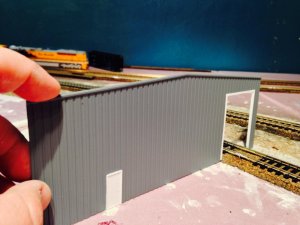Hey everyone,
I hope this isn't a repeat topic, I searched for a while but nothing answering my questions. So if you don't mind, I have a few.
1. What kind (meaning acrylic, oil, etc,) of paint do I use to paint structures?
An example would be, I purchased the Atlas Passenger station kit and platform kit- I think I can work with it, but everything is this ugly green and obviously needs paint.
2. Does any of this ever need priming? Some of the parts seem quite shiny and therefore slippery?
3. Given that that is one paint type you are suggesting, what is the paint to water ratio for a syphon feed airbrush? Psi?
4. Is it always better to paint prior to assembly or does this create building issues later?
5. I picked up some Hobby Lobby acrylics for about $2-3 each, are these cruddy paints I would not want to use?
6. I have heard some people talk about a dull-coat - does that apply here or is even necessary when using flat paints?
Thanks in advance for your expert advice- I am glad I'm a part of a forum with such helpful people!
Silas
Edit: I just realized there is a painting sub-forum and I'm not sure how to move this, sorry for that.
I hope this isn't a repeat topic, I searched for a while but nothing answering my questions. So if you don't mind, I have a few.
1. What kind (meaning acrylic, oil, etc,) of paint do I use to paint structures?
An example would be, I purchased the Atlas Passenger station kit and platform kit- I think I can work with it, but everything is this ugly green and obviously needs paint.
2. Does any of this ever need priming? Some of the parts seem quite shiny and therefore slippery?
3. Given that that is one paint type you are suggesting, what is the paint to water ratio for a syphon feed airbrush? Psi?
4. Is it always better to paint prior to assembly or does this create building issues later?
5. I picked up some Hobby Lobby acrylics for about $2-3 each, are these cruddy paints I would not want to use?
6. I have heard some people talk about a dull-coat - does that apply here or is even necessary when using flat paints?
Thanks in advance for your expert advice- I am glad I'm a part of a forum with such helpful people!
Silas
Edit: I just realized there is a painting sub-forum and I'm not sure how to move this, sorry for that.
Last edited by a moderator:




